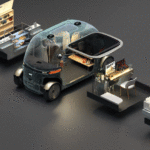World-renowned Danish footwear brand ECCO is looking to launch a new pilot project for incorporating 3D printing into footwear production. While 3D printed sneakers is nothing new by itself, this project really shines in the details. The idea is to bring custom 3D printed shoes to the average consumer through their Amsterdam concept store.
The brain-child of Innovation Lab ECCO (ILE), the QUANT-U project can in theory produce shoes in just a few hours. Moreover, the store will tailor the shoes to the exact specifications and fitting of the customer. The method is highly data-driven and elaborate. It presents the first real model of customisable fashion products at a mass market scale.
“We see a lot of activity on the subject of 3D printed footwear without a solid solution for true mass customization from competitors,” commented Patrizio Carlucci, the Head of ILE. “Additive manufacturing offers the chance to create bespoke parts in series but this is rarely translated in a consumer product; most likely due to the complexity of the 3D models and a lack of measuring data to begin with. To solve this, we focused heavily on the digital capture and interpretation of motion and orthotic data, then made sure this experience would be no more complicated than trying on a shoe in the store and walking for a few minutes. We truly translated more than 50 years of shoe making experience into an algorithm.”
3D Sensors, Scanners & Printers
The company summarises its processes in 3 steps: real-time analysis, data-driven design, and in-store 3D printing. The initial step is to create a digital footprint of the wearer through anatomical 3D scans and sensor data. The footprint also captures the wearers exact fit and the specifics of their foot movement. While it may seem complicated, this part of the process only takes about 30 seconds.
The scanning technology was developed by the UK-based Cambridge Design Partnership, allowing Ecco to capture the exact gait of its customers. The sensors measure a plethora of data using gyroscopes and pressure sensors and accelerometers. It even employs the use of humidity and heat sensors to calibrate the exact characteristics one would want.
After compiling the data, ECCO can create a 3D model of a customized midsole for the wearer. Dassault Systèmes’ FashionLab came up with the software for generating the midsole. The software uses machine learning to arrive at the ideal fit. It compares the designs using cloud-computing to generate the best output. Once this stage is complete, ECCO use German RepRap 3D printing systems to produce the midsoles. DOW Chemical provided the silicone-based material for these processes.












